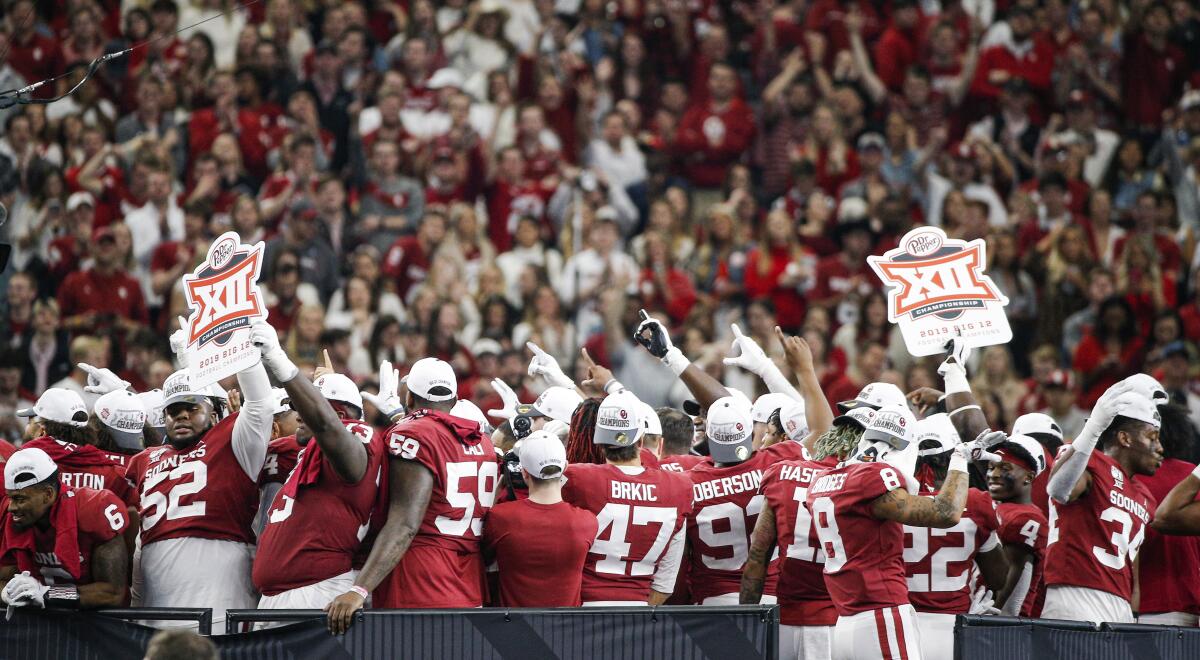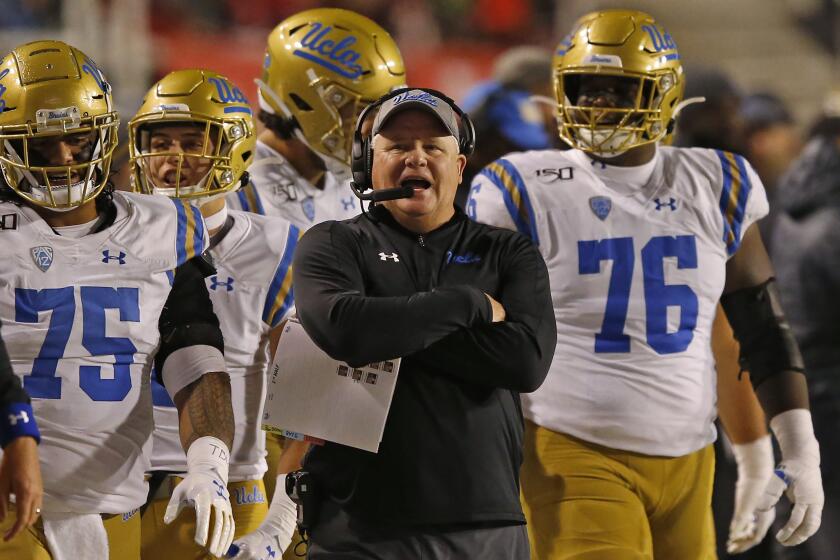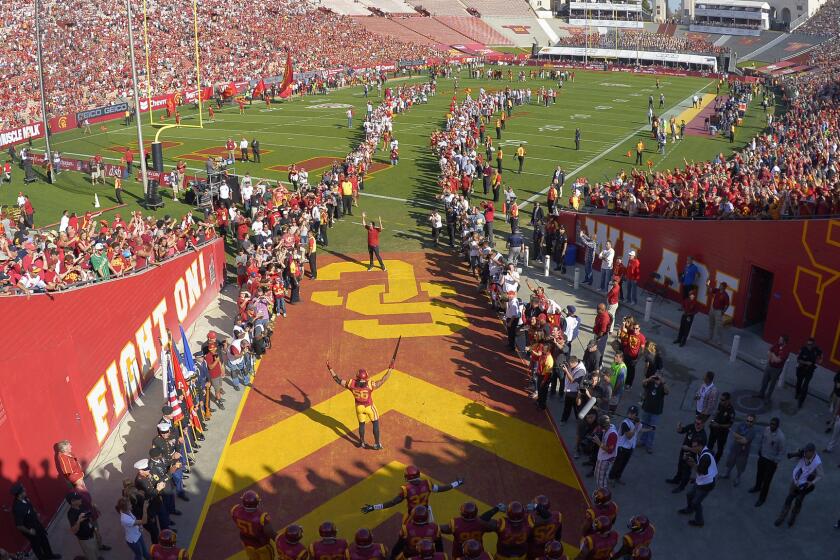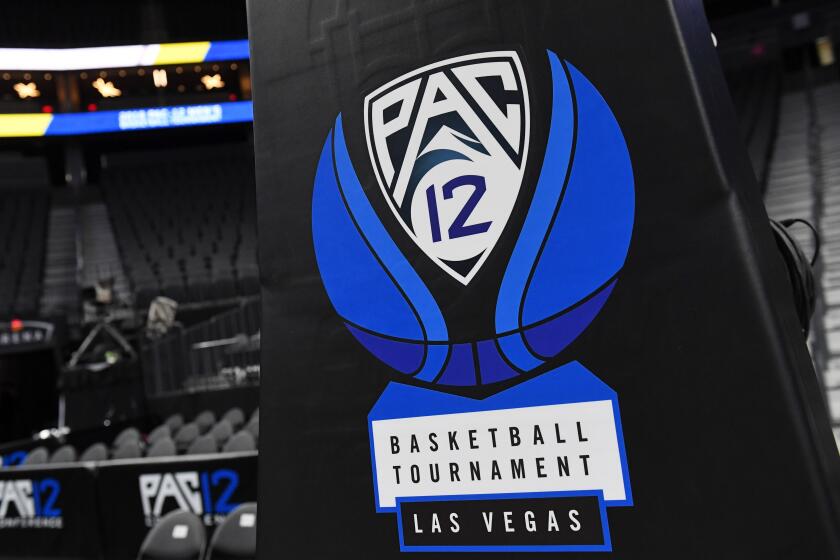One infectious disease expert calls staging college sports ‘playing with fire’

- Share via
The Big 12 Conference is giving fall football a go. The Pac-12 and Big Ten have said no.
Which governing body is taking the best approach as their college counterparts grapple with the decision to play amid a raging pandemic? Two infectious disease experts and members of the NCAA’s COVID-19 advisory panel suggested Thursday that it would be prudent to shut down fall sports until the novel coronavirus outbreak can be more adequately contained.
One of the experts compared holding fall sports to “playing with fire” because of heart inflammation risks from COVID-19 and another said sports shouldn’t go on because of the nation’s inability to keep the virus from spreading unabated, with more than 162,000 deaths reported since the end of February.
“I feel like the Titanic — we have hit the iceberg and we’re trying to make decisions of what time should we have the band play,” Dr. Carlos del Rio, executive associate dean at Emory University School of Medicine at Grady in Atlanta, said during a video teleconference with reporters. “I mean, we need to focus on what’s important, and what’s important right now is that we need to control this virus. Not having fall sports this year and controlling this virus, to me, would be the No. 1 priority, so my advice to colleges is if you cannot do it safely, you should not do it.”
UCLA football coach Chip Kelly contracted the novel coronavirus in March and has since recovered after experiencing mild symptoms.
Del Rio said his magic number for acceptable community spread was less than 10 and ideally five or fewer new cases per day per 100,000 people, far less than the roughly 30 per 100,000 he’s experiencing in his home state of Georgia. Should college sports forge ahead in a state where 98% of hospital beds and 97% of intensive care units were at capacity, del Rio said, it would be a recipe for disaster.
“We don’t have a lot of capacity to take care of sick people, and if you were to have an outbreak bigger than what we have because some kind of sports event or college event, you would be in a very serious situation,” del Rio said. “I don’t want to be there, so my advice is that we’ll hold off and we’ll control this virus.”
Earlier this month, the NCAA’s board of governors released requirements for schools and conferences to proceed with fall sports, including an adherence to federal, local and state guidelines. The uncertainty has deepened because conferences are interpreting those same guidelines and emerging medical data in differing ways.
“All of us are just learning about this disease in the last seven months and so there is no black-and-white answer,” said Dr. Brian Hainline, the NCAA’s chief medical advisor, “but we think the guidance, which is a mandate, provides a pathway for which decisions will be made.”
The college football season is in serious peril because of the COVID-19 pandemic. But what spurred the Big Ten to push for the season to be canceled?
Del Rio compared the decision of whether to play to the one someone might face when trying to cross the road despite an oncoming car: it’s based on how much risk one was willing to accept.
“Some conferences will say, ‘Well, you know, we’ll go forward, it’s a very narrow path and hopefully there will be no infections and if there are infections we’ll be able to detect them and stop them and we won’t have an outbreak,’ ” del Rio said, “but other conferences will say, ‘No, our tolerance is for zero risk and therefore we would rather not have it.’ ”
Those risks appear to have heightened amid new data that indicates athletes who contract COVID-19 have an increased chance of experiencing myocarditis, a rare inflammation of the heart. Hainline said 1% to 2% of college athletes were testing positive for the virus and he was aware of “about 12 cases” of myocarditis. The NCAA is updating its requirements for athlete care after a positive test to protect them from heart issues.
Of course, the best protection of all would be not to get the virus in the first place.
“I think we’re playing with fire,” said Dr. Colleen Kraft, an infectious disease expert and member of the NCAA’s COVID-19 advisory panel. “I think one case of myocarditis in an athlete is too many. ... I don’t want to see stories of athletes who can no longer play simply because somebody didn’t protect themselves.”
USC athletic director Mike Bohn said the Pac-12’s cancellation of fall sports was the result of too much uncertainty moving forward during the coronavirus pandemic.
Preventing football players from catching the virus goes beyond using new visors that act as face shields and masks fitted inside the helmet that are designed to contain droplet spread. Players must also be protected from their communities where infection is most likely to occur by following guidelines for social distancing, hand washing and mask wearing.
Those conferences that have pushed back their seasons to the spring are hoping improved conditions can herald decreased risk of virus transmission, particularly if vaccines are developed and rapid testing becomes more widely available.
“I’m very confident that sometime in March or April of next year, we will have one or several vaccines that have proven to be effective,” del Rio said. “So one thing I say is that this epidemic is not forever, we are going to find our way out.”
UCLA coach Mick Cronin and USC coach Andy Enfield have tossed around ideas on what the 2020-2021 college basketball season could look like including a bubble concept and May Madness tournament.
Then again, many athletic administrators and medical experts also figured that college sports would be feasible in the fall, assuming that the pandemic that started last spring would by then be under control. If they’re not possible in six months, Americans may only have themselves to blame.
“If we don’t start ratcheting up our public health policies, this is going to be happening for a long time and the numbers are not going to seem numbers to anybody any longer, they’re going to be individuals that people know,” Kraft said. “More and more people are going to experience this problem, this tragedy, this infection if we continue as we’re going now.”
More to Read
Go beyond the scoreboard
Get the latest on L.A.'s teams in the daily Sports Report newsletter.
You may occasionally receive promotional content from the Los Angeles Times.















